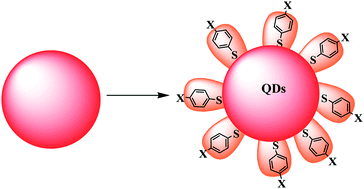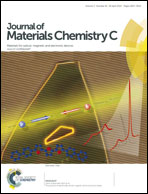Prolonging the lifetime of excited electrons of QDs by capping them with π-conjugated thiol ligands†
Abstract
The lifetimes of the excited electrons (photoluminescence lifetime) of quantum dots (QDs) have an important effect on the electron transfer efficiency between QDs and other substances and thus determine their application. Here, a new strategy to prolong the photoluminescence (PL) lifetime of quantum dots (QDs) by using π-conjugated ligands together with thioglycolic acid (TGA) as the QD's ligand shell is reported. 4-Mercaptobenzoic acid (4-MBA), 4-methylbenzeneththiol (4-MBT) or 2-mercaptobenzothiazole (2-MBTH) was selected as π-conjugated ligand together with thioglycolic acid (TGA) to synthesize aqueous CdTe quantum dots (QDs). The decay curves of TGA–CdTe, 4-MBA–TGA–CdTe, 4-MBT–TGA–CdTe and 2-MBTH–TGA–CdTe (λem = 550 nm) were recorded and their average PL lifetimes were calculated. The HOMO and LUMO energy levels of 4-MBA, 4-MBT and 2-MBTH were calculated with Gaussian 09W. By comparing lifetimes of QDs capping by different ligands relating to the HOMO and LUMO energy levels of ligands, we presume that in the QDs/π-conjugated ligand hybrid, an electron delocalized field is formed by mixing the LUMO energy levels of π-conjugated ligand with conductive band-edge energy (Ecb) of CdTe QDs, which will supply the excited electron with a more stable environment. As a result, the PL lifetime of CdTe QDs is prolonged greatly (from 49 ns to 80 ns) when a π-conjugated ligand with appropriate LUMO energy level was used as ligand shell.


 Please wait while we load your content...
Please wait while we load your content...